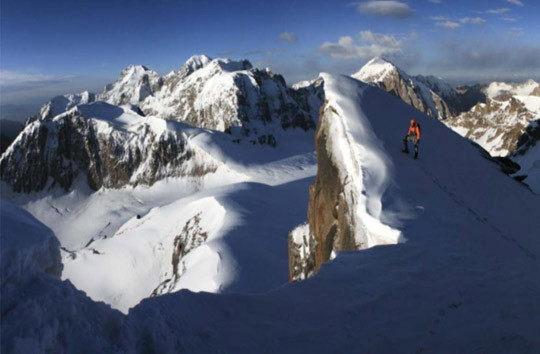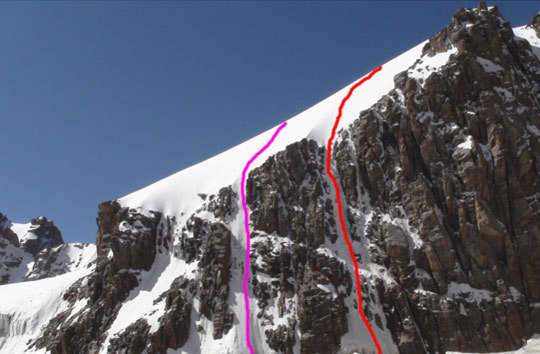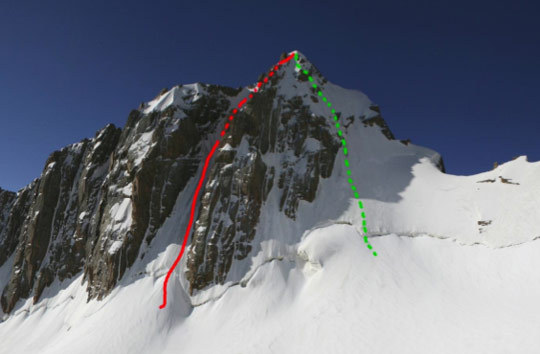
The rugged Kokshall Too Range, on the border of Kyrgyzstan and China. The Slovenian Freeapproved Expedition spent twenty-three days in early July, 2008, in the Kokshall Toos filming first ascents and ski descents.
In early July, the Slovenian Freeapproved Adventure Film Productions teama–comprised of myself, Jeglic, Orazem, Ortar, Rutar, Skrinjar, sumrada and Virc–headed off for a climbing, skiing and filming adventure in the Kokshall Too Range of Kyrgyzstan. The range borders China, and has been fairly well-visited in the far western and eastern ends. However, the middle part of these mountains are far less explored. And it’s easy to imagine why.
After traversing the whole country of Kyrgyzstan, and successfully passing through three military checkpoints, we finally got our first glimpse of the fabulous Kokshall Too Mountains. When we saw them, we understood why their name means “celestial mountains”–they were truly a heavenly sight!
The younger half of the expedition proved to be the impatient one. We spent an extra day route finding among the wet-lands and swamps (in which even the six-wheel drive, 13-ton Ural truck is rendered powerless) before arriving at base camp. Immediately, the team headed for the mountains.
We established base camp at 3715m near a river. Over 20 km of unknown and horrifically rugged terrain stood between us and the walls and ski descents that we had come so far to challenge.
The hike to the advance base camp proved to be very strenuous–not only because of backpacks that felt like entire wardrobes being carried on our backs, but also because of the seemingly endless moraine. Constant ups and downs, difficult route finding, steep scree slopes and falling sleet and rain stole any trace of fun from the trek. After a full day of effective hiking, the team decided to make an intermediate camp on the moraine. Unfortunately, our night’s sleep was disturbed by “The Grand Poohbah Serac Band”–playing quite intensely on the edge of Pik Biyely’s (aka Grand Poohbah, 5697m) east face. The symphony was composed of the rumbling sounds of falling ice smashing against perfect granite, ever accompanied by the sound of the wind.
We set up advance base camp on the flat part of the Fersmana glacier at 4447m. Except for Pik Neizvestny (5230m), all of the summits around us were still unclimbed. The next day, the team approached the short and steep Pik Anin (4807m) north face. The team split into two groups, and Arne Jeglic, Tadej Orazem and I climbed the obvious ice line Bloody Aurikelj (V/5). Ice was good on the lower part but worsened higher up the route; it was hollow and therefore difficult to place protection in some places. Bor Sumrada, Jaka Ortar, Jani Rutar and Jani Skrinjar climbed the next obvious line to the left, and despite the night’s cold temperatures, the sun melted fresh snow from above. Running water beneath the ice made for a perfect route named Waterfull (IV/4). Both groups joined for the summit ridge and completed a first ascent of Pik Anin! Jaka, Jani and Janez skied to the other side via the couloir (Ice Crevasse Direct, IV), completing the first ski descent.

North Face of Pik Anin, Kokshall Too Range, Kyrgyzstan, as climbed by the Slovenian Freeapproved Expedition. Red line indicates Bloody Aurikelj (V/5, 350m). Purple line indicates Waterfull (IV/4, 300m).
The glacier was very treacherous with knee-deep slushy snow covering the crevasses and Jaka, was the first to fall into one. He had to return to rescue his skis–once he had regained the strength and confidence to abseil deep into the darkness below. Tadej was the next to take a fall. Fortunately, we were all roped up, so there were no serious injuries. However, Tadej was unlucky enough to have twisted his ankle in his fall when his crampon snagged the ice.
After a day’s rest everyone was ready for more climbing and skiing, only to be set back by a day-long snow storm. Luckily, it subsided the next evening, giving us clear skies and bitter cold; it was perfect for more climbing and skiing.
Arne and I went for the unclimbed Zastava (5070m) north face, struggling on the approach in deep snow over old slush on the broken glacier. We chose the most obvious and direct line, a broad couloir they had hoped would be straightforward. The initial bergschrund pitch was more challenging than we had anticipated–10 full rope lengths on brittle old ice covered by 2 inches of extremely soft snow. The couloir eased toward the top, but the col on the ridge leading to the summit was overhung with cornices, forcing us to back climb the last pitch down the couloir. we instead climbed moderate mixed pitch, followed by another traverse pitch on ice, and finally stood on the virgin summit of Zastava (FAT Couloir Direct VI/4, M). We shouted from the summit so loudly that our friends in ABC heard us kilometers away! The descent required eight full-length abseils over the west-northwest face.

Pik Zastava (5070m), Kokshall Too Range, Kyrgyzstan, as climbed by the Slovenian Freeapproved Expedition in July, 2008. Red line indicates ascent via FAT Couloir Direct (VI/4, 10 pitches, 600m). Green line indicates route of descent.
Other ascents by Jaka, Jani, Bor and Janez included Fers 3 SW face (only up to the ridge) and a new ski descent named Found. Bor and Janez ascended the west couloir and north ridge up to the virgin summit of Plaza (4905m). Bor, Janez and Bostjan also made a reconnaissance trip to the Chinese border, spotting a possible line up Pik Byiely. Jaka and Jani also skied an impressively steep and icy line down Pik Neizvestny’s east face (Hidden Ice, VI).
The day before the descent to the basecamp, the pair of twenty-year-olds–Arne and Jaka–went for the highest unclimbed peak in this part of the range–Pik Byiely. They left advance base camp at 2:30 a.m., reached the Chinese saddle on skis, and continued climbing the south ridge and couloirs avoiding the seracs. After witnessing the avalanche and lots of spindrift, they recalled my adage–“A good mountaineer is an old mountaineer”–and ended their attempt 300m short of the summit.
The 21-hour rescue-hike over a 20km course of arduous terrain with one-legged Tadej–who was alternately carried on the backs of Arne and myself–rounded out the perfect and successful expedition in this remote, barely touched area. When we finally returned home, Tadej ended up requiring surgery to fix torn ligaments in his ankle.
The Slovenian Freapproved Kyrgysztan adventure was filmed with Hi-Definition camcorders, and over 14 hours of digital video material was shot. The premiere screening of the documentary will be broadcast this winter.